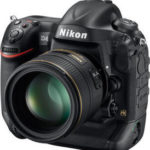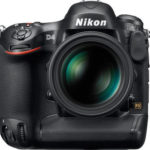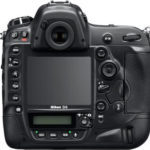 PRESS SUMMARY – Nikon Corporation announced the release of the Nikon D4, a Nikon FX-format camera that serves as the new flagship model in Nikon’s lineup of digital-SLR cameras.
PRESS SUMMARY – Nikon Corporation announced the release of the Nikon D4, a Nikon FX-format camera that serves as the new flagship model in Nikon’s lineup of digital-SLR cameras.
The D4 is equipped with a new Nikon FX-format CMOS image sensor (36.0 x 23.9 mm) and EXPEED 3, the latest image-processing engine specifically optimized for digital-SLR cameras, making it the next-generation flagship Nikon digital-SLR camera with the ultimate in versatility and functionality that offers superior image quality rich in detail along with excellent high-speed performance. It has an effective pixel count of 16.2-million pixels, and offers superior image quality under a broad range of lighting conditions from ISO 50 to ISO 204800.
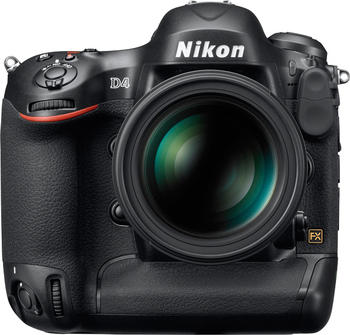
The new 91K-pixel RGB sensor supports the Advanced Scene Recognition System, which is able to recognize human faces even when images are framed using the optical viewfinder. In addition, the Advanced Scene Recognition System offers significant improvements in AF, AE, i-TTL flash control, and auto white balance (AWB) control accuracy. The 51 focus point AF system has been improved with faster initiation of autofocusing and the ability to detect and focus on subjects with less lighting. Eleven focus points are fully functional when lenses with a maximum aperture of f/8 are used. All of this means more precise autofocusing when super-telephoto NIKKOR lenses are used with teleconverters (2.0x). The Multi-area Mode Full HD D-movie movie recording function is capable of recording full-HD movies at 30 fps, and offers three movie recording formats for selection according to recording conditions or creative intent.
The D4 records images to memory cards faster with built-in support for high-speed, UDMA 7 compatible CompactFlash memory cards and next-generation, high-speed XQD memory cards. In addition to built-in wired LAN features, the D4 also supports high-speed image transfer via wireless LAN when the new Wireless Transmitter WT-5 (available separately) is connected to the camera. The D4 is also equipped with a number of new functions that support a more efficient workflow for professional photographers, including one that allows users to add IPTC (International Press Telecommunications Council) information to images.
Features:
New Nikon FX-format CMOS image sensor
The D4 is equipped with a new Nikon FX-format CMOS image sensor (imaging size of 36.0 x 23.9 mm) developed by Nikon. The superior performance of the FX-format CMOS image sensor with its effective pixel count of 16.2-million pixels offers excellent resolution and image quality under an incredible variety of lighting conditions. Despite the increase in pixel count, the D4 reads out data faster than the D3S. The range of standard sensitivities has been expanded to ISO 100 to ISO 12800. What’s more, support for ISO 50 and additional expansion up to ISO 204800 is also possible, enabling effective shooting under a variety of lighting conditions without concern for any sacrifice in image quality.
New EXPEED 3 image-processing engine with superior, high-speed processing capabilities
The new EXPEED 3 image-processing engine built into the D4 offers better image quality and even faster processing speeds for vivid yet faithful color reproduction, a broader dynamic range, and rich expression of tones. It also effectively suppresses noise with advanced noise-reduction processing for images captured at high sensitivities under dim lighting, all while preserving definition and sharpness. Noise-reduction processing designed especially for movies maintains crisp, clear outlines in movies recorded in low-light situations. EXPEED 3 has high-speed processing capabilities for a variety of task, and it uses power effectively, contributing greatly to the camera’s power-saving design.
91K-pixel RGB sensor for the more accurate Advanced Scene Recognition System
The D4 is equipped with the Advanced Scene Recognition System, which supports face recognition* when images are framed using the optical viewfinder. The new 91K-pixel (approximately 91,000 pixels) RGB sensor recognizes human faces for more frequent focus acquisition on human faces when Auto-area AF AF-area mode is used. When a human face is detected in the frame, 3D Color Matrix Metering III bases exposure control on the brightness of that face so that the face is optimally exposed even with backlighting. In addition, the high resolution of the metering sensor with its roughly 91,000 pixels enables extremely precise analysis of the scene for more accurate control over autofocusing, auto exposure, i-TTL flash control, and auto white balance.
*There is no display in the viewfinder that shows when a face or faces have been recognized.
Faster and more accurate AF with 51 focus points
The 51 focus point AF system built into the D4 utilizes the new Advanced Multi-CAM 3500FX autofocus sensor module for faster, more accurate autofocusing that performs extremely well under dim lighting.
The 15 focus points at the center of the frame are cross-type sensors that detect phase differences both horizontally and vertically. All 51 focus points are fully functional when lenses with a maximum aperture of up to f/5.6 are used, and the cross-type sensors make the most of this capability. Precise focus can be quickly acquired with autofocusing using all AF NIKKOR lenses, even under lighting as dim as −2 EV (ISO 100, 20°C/68°F), the level at which the scene through the viewfinder can just be made out by the human eye. Eleven focus points (five at center with an additional three to each side) are fully functional when lenses with a maximum aperture of f/8 are used. This enables very precise focus acquisition with sports photography and the like when super-telephoto NIKKOR lenses are used with a teleconverter (2.0x) at a combined aperture value of f/8.
In addition, adoption of a new algorithm enables faster autofocus initiation for even more certain and sharper capture of defining moments especially necessary when shooting sports scenes. The new high-speed AF system also supports high-speed continuous shooting at approximately 10 fps* in FX format with AF and AE tracking.
*Measured according to CIPA guidelines. Value with shooting in AF-C autofocus mode, [S] or [M] exposure mode, shutter speed of 1/250 s or faster, all other settings at their default values.
Multi-area Mode Full HD D-movie with three image area options
A dedicated movie-record button has been positioned near the shutter-release button for smooth starting and stopping of movie recording with a feel similar to that of still-image shooting. Full-HD movie recording at a frame size of 1920 x 1080 and frame rate of 30 fps is supported, and the H.264/MPEG-4 AVC video compression method has been adopted. Movies up to 29 minutes 59 seconds*1 can be recorded. Image sensor sensitivity begins at ISO 200 and can be expanded to the same ISO 204800 equivalent possible with still-image shooting.
Full-HD movies can be recorded with the D4 using one of three image areas: FX-based movie format*2, DX-based movie format, or 1920 x 1080; 30 fps/25 fps/24 fps crop. FX-based movie format makes full use of the large image sensor, enabling movies with an emphasis on pleasing blur characteristics. When a DX lens is attached, DX-based format is automatically selected. This format is useful for creating an extension to the focal length of an existing lens. For an even stronger telephoto effect, the 1920 x 1080 crop format brings an approximately 2.7x crop of the picture angle while delivering outstanding video quality and detail, obtaining 1080p Full HD. By choosing the movie format appropriate for the particular scene, the three image area options available with a single camera enable more flexible imaging expression through collaboration with the entire NIKKOR lens lineup, including DX lenses.
The D4 is equipped with a connector for external microphones that enables stereo recording. The camera also offers a headphone connector that supports stereo headphones, convenient for checking sound recorded with movies.
*120 min. depending on frame size/rate and movie quality settings.
*2Movies are recorded with an aspect ratio of 16: 9 regardless of the format selected. Aspect ratio is 3 : 2 with recording at a frame size/rate of 640 x 424; 30 fps and 640 x 424; 25 fps.
Smooth workflow from initial setup to image transfer
The entire photographic workflow is faster with the D4. Superior, high-speed response with a power-up time of approximately 0.12 s*1 and a release time lag of roughly 0.042 s*1. In addition, support for high-speed, next-generation XQD memory cards enables a continuous shooting frame rate of 10 fps for up to approximately 100 shots even when shooting in RAW format*2. The camera is also equipped with dual memory card slots, one for XQD memory cards and one for CompactFlash memory cards, for smooth handling of images. Professional photographers can work much faster with high-speed transfer of images to a computer when an XQD memory card reader supporting SuperSpeed USB (USB 3.0)*3 is used.
*1Measured according to CIPA guidelines
*2When a Sony XQD memory card H-series (QD-H16G, QD-H32) is used with capture of compressed 12-bit NEF (RAW) images (based on Nikon testing standards)
*3Sony MRW-E80 (based on Sony testing standards)
The new compact Wireless Transmitter WT-5 with simple connection to the camera
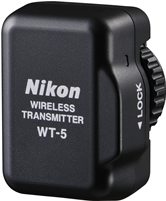 The D4 is equipped with an Ethernet port and functions for wired LAN connections. In addition, it also supports the new WT-5 (available separately), a compact wireless transmitter that is easily connected to the camera for high-speed transfer of images over a wireless network.* The D4 is also equipped with a number of new functions that support a more efficient workflow for professional photographers, including one that allows users to add IPTC (International Press Telecommunications Council) information to images.
The D4 is equipped with an Ethernet port and functions for wired LAN connections. In addition, it also supports the new WT-5 (available separately), a compact wireless transmitter that is easily connected to the camera for high-speed transfer of images over a wireless network.* The D4 is also equipped with a number of new functions that support a more efficient workflow for professional photographers, including one that allows users to add IPTC (International Press Telecommunications Council) information to images.
The new WT-5 is powered by the camera, making a more compact size possible. In addition to IEEE 802.11a/b/g standards, the WT-5 also supports the new IEEE 802.11n (1 x 1) standard, enabling data transfer at twice the speed possible with the WT-4. The camera’s HTTP server mode can be used to display a list of images stored on the memory card, and also enables basic camera control, live view, movie recording, etc. using the Web browser on a computer or smartphone. Synchronized release (WT-5 only) mode enables synchronized shutter release of up to 10 D4 cameras, each with its own WT-5 with the D4 used as the controlling “master”.
*The Wireless Transmitter WT-4 can also be used.
Other D4 functions and features
- Extremely durable shutter that has passed testing for 400,000 cycles
- Magnesium alloy adopted for the very strong, durably body that is very resistant to dust and water
- Effective sealing using O rings and packing make the camera more resistant to dust and water
- Silent shutter-release mode for live view photography that almost completely eliminates the sounds of the mirror and shutter operation
- A time-lapse photography feature, with which the camera automatically takes photos at selected intervals to record a time-lapse movie, which can be played back at 24–36,000x normal playback speed
- Operation optimized for both horizontal (landscape) and vertical (portrait) shooting
- Button backlights (illuminators) for increased visibility when working in dimly lit or dark situations
- High-performance viewfinder, utilizing a glass pentaprism, with a frame coverage of approximately 100% (FX format) and magnification of approximately 0.7x
- Four image area options for still shooting—FX (36 x 24), 5:4 (30 x 24), 1.2x (30 x 20), DX (24 x 16)—with viewfinder indicator that identifies the current image area
- A 3.2-inch, approximately 921k-dot LCD monitor with reinforced glass and wide viewing angle; integration of the glass and panel reduce internal reflections
- A virtual horizon that shows the degree to which the camera is tilted sideways (roll), forward or backward (pitch) with display in the monitor and viewfinder
- White balance that can be adjusted in units of 10 K; white balance can be specified separately for shooting (white balance applied to images) and monitor display with still-image shooting in live view mode
The Nikon D4 is estimated to be available in February 2012 for a retail price of $5,999.95 (body only).
–
*The Current Photographer website contains links to our affiliate partners. Purchasing products and services through these links helps support our efforts to bring you the quality information you love and there’s no additional cost to you.
Founder of Current Photographer, co-host of The Digital Photography Cafe Show, Designer, Photographer, and overall tech geek.
